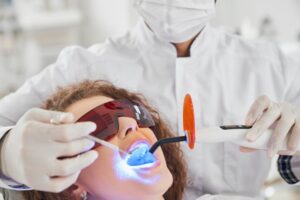
Have you ever heard stories about your parents’ or grandparents’ dental experiences? For past generations, filling and capping teeth with metal was common practice. When you grow up constantly asking to see grandma’s silver tooth, it can be surprising when you visit the dentist yourself and find out you could get a tooth-colored cosmetic treatment instead.
Of course technology advances, but that kind of concept is something we take for granted. It makes you wonder how far cosmetic dentistry has come through the years. You’re in luck! For the curious souls out there, we have a brief overview of some dental history highlights.
Cosmetic Dentistry That Was Not So Unorthodox for The Ancients
Today, we can enjoy the aesthetic sensibilities and convenience of dental implants. But if you were wanting to replace a smile gap with a false tooth as an Etruscan in 700 B.C., your options were ivory, bone, or “lived-in” teeth from deceased animals or humans. While an ivory tooth does sound luxurious, the others just seem like an infection waiting to happen!
Ancient dental cosmetics got even more…interesting as the Etruscans slowly developed into Romans. To whiten their teeth, Romans used their own urine as a sort of mouthwash. That fact speaks for itself. Although it is humorous to picture Juluis Ceaser trying to wash out dental stains this way.
Teeth whitening continued to use questionable techniques in the Middle Ages. First of all, you would have to go to your barber for dental needs. Yes, the same people who used white and red barber poles to symbolize the bandages and blood involved in their trade. Apparently, they applied some sort of mysterious coating to remove dental discoloration – a coating that ultimately destroyed enamel and caused more problems.
You’ll be happy to know that your modern cosmetic dentist will use safe, FDA-approved teeth whitening methods!
The Origins of Infamous Metal Dental Restorations
Metal materials have been used in dentistry since the 1800’s. At first, metal teeth were used as replacements, but were not very effective. The use of metal gradually moved away from applications below the gumline and was incorporated into dental repair. Metallic fillings and crowns reached their peak in the 1970’s – which, of course, is when many family members received them.
Fun fact: metal restorations contain trace amounts of mercury. In the early 1990’s, advances in ceramic and composite materials and valid fears of mercury exposure created the perfect storm for tooth-colored versions of this treatment to take over. Now when you visit your dentist, you can ask for a cosmetically flawless and mercury-free dental restoration!
Projecting Into the Future of Cosmetic Dentistry
Dentistry, and especially cosmetic dentistry, has seen drastic improvement in recent years. Professionals believe that advances will continue. We’re already seeing emerging techniques that make many treatments more efficient and less time-consuming. If you’re thinking about consulting with your dentist about enhancing your smile, now’s an exciting time to start!
About the Author
Dr. Bryan Villescas enjoys helping patients achieve flawless smiles. He knows dentistry is an ever-evolving field, and that new technologies constantly change how treatments are administered. That’s why he never stops learning! At Dr. Villescas office, you can rest assured you’re getting the best service available. To contact his office, call 941-627-9900 or explore his website for more information.
